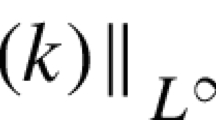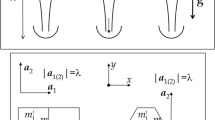Abstract
We reformulate the renormalization group (RNG) and theɛ-expansion for derivation of turbulence models. The procedure is developed for the Navier-Stokes equations and the transport equations for the kinetic energyK and energy dissipation rate ℰ. The derivation draws on the works of Yakhot and Orszag (1986) and Smith and Reynolds (1992), and all results are found at low order in the underlying perturbation expansion in powers ofɛ. The sum of the source terms in the ℰ-equation is known to beO(1) due to the balance at leading order ofO(R 1/2T ) terms. Smith and Reynolds (1992) showed the cancellation of some of theO(R 1/2T ) terms generated by the RNG procedure. Here we show that including the random-force contribution to ℰ-production results in the cancellation ofall theO(R 1/2 T ) terms. We find that two of theO(1) terms in the RNG equation for the mean dissipation rate ℰ have the same form as those in the widely used model
-equation. The values of the coefficients of the familiar terms are close to those used in practice. An extra production term is predicted which is small for slow distortions, but important for rapid distortions. Hence, it may be a term that should be added to the
model equation. We believe that the present derivation places the
model equation on a more solid theoretical basis.
Similar content being viewed by others
References
Batchelor, G. K., and Townsend, A. A. (1948). Decay of turbulence in the final period,Proc. R. Soc. London A194, 527.
Comte-Bellot, G., and Corrsin, S. (1966). The use of contraction to improve the isotropy of grid-generated turbulence,J. Fluid Mech. 25, 657.
Dannevik, W. P., Yakhot, V., and Orszag, S. A. (1987). Analytical theories of turbulence and theɛ-expansion,Phys. Fluids 30, 2021.
De Dominicis, C., and Martin, P. C. (1979). Energy spectra of certain randomly stirred fluids,Phys. Rev. A 19, 419.
Durbin, P. A. (1990). Turbulence closure modeling near rigid boundaries, Annual Research Briefs—1990, Center for Turbulence Research, Vol. 3.
Durbin, P. A., and Speziale, C. G. (1991). Local anisotropy in strained turbulence at high Reynolds numbers,ASME J. Fluids Eng. 113, pp. 707–709.
Forster, D., Nelson, D. R., and Stephen, M. J. (1977). Large-distance and long-time properties of a randomly stirred fluid,Phys. Rev. A 16, 732.
Fournier, D., and Frisch, U. (1983). Remarks on the renormalization group in statistical fluid dynamics,Phys. Rev. A 28, 1000.
Launder, B. E., Reece, G. J., and Rodi, W. (1975). Progress in the development of a Reynolds-stress turbulence closure,J Fluid Mech. 68, 537.
Lee, M. J., and Reynolds, W. C. (1985). Report TF-24, Mechanical Engineering Department, Thermosciences Division, Stanford University.
Majda, A., and Avillaneda, M. (1990). Mathematical models with exact renormalization for turbulent transport,Commun. Math. Phys. 131, 381.
Mansour, N. N., and Shih, T.-H. (1989).Forum on Trubulent Shear Flows—1989, FED Vol. 76, Am. Society of Mech. Eng., New York.
Migdal, A. A., Orszag, S. A., and Yakhot, V. (1990). Intrinsic stirring force in turbulence and theℰ-expansion, Princeton University preprint.
Millionshtchikov, M. D. (1939). Decay of turbulence in wind tunnels,Dokl. Akad. Nauk SSSR 22, 236.
Orszag, S. A. (1970). Analytical theories of turbulence,J. Fluid Mech. 41, 363.
Panda, R., Sonnad, V., and Clementi, E. (1989). Turbulence in a randomly stirred fluid,Phys. Fluids A 1, 1045.
Patel, V. C., Rodi, W., and Scheurer, G. (1985). Turbulence models for near-wall and low Reynolds number flows: A review,AIAA J. 23, 1308.
Reynolds, W. C. (1976). Computation of turbulent flows,Ann. Rev. Fluid. Mech. 8, 183.
Shih, T.-H., Reynolds, W. C., and Mansour, N. N. (1990). A spectrum model for weakly anisotropic turbulence,Phys. Fluids A 2.
Smith, L. M., and Reynolds, W. C. (1992). On the Yakhot-Orszag renormalization group method for deriving turbulence statistics and models,Phys. Fluids A 2, 364.
Speziale, C., Gatski, T. B., and Fitzmaurice, N. (1991). An analysis of RNG-based turbulence models for homogeneous shear flow,Phys. Fluids. A 3, 2278.
Tan, H. S., and Ling, S. C. (1963). Final stage decay of grid-generated turbulence,Phys. Fluids 6, 1693.
Tennekes, H., and Lumley, J. L. (1972).A First Course in Trubulence, MIT Press, Cambridge, MA.
Yakhot, V., and Orszag, S. A. (1986). Renormalization group analysis of turbulence. I. Basic theory,J. Sci. Comput. 1, 3.
Yakhot, V., and Orszag, S. A. (1990). Analysis of theɛ-expansion in turbulence theory: Approximate renormalization group for diffusion of a passive scalar in a random velocity field, Princeton University preprint.
Yakhot, V., Orszag, S., and Panda, R. (1988). Computational test of the renormalization group theory of turbulence,J. Sci. Comput. 3, 139.
Yakhot, V., Thangam, S., Gatski, T. B., Orszag, S. A., and Speziale, C. G. (1992). Development of turbulence models for shear flows by a double expansion technique, to appear inPhys. Fluids A,7.
Author information
Authors and Affiliations
Rights and permissions
About this article
Cite this article
Yakhot, V., Smith, L.M. The renormalization group, the ɛ-expansion and derivation of turbulence models. J Sci Comput 7, 35–61 (1992). https://doi.org/10.1007/BF01060210
Received:
Issue Date:
DOI: https://doi.org/10.1007/BF01060210




